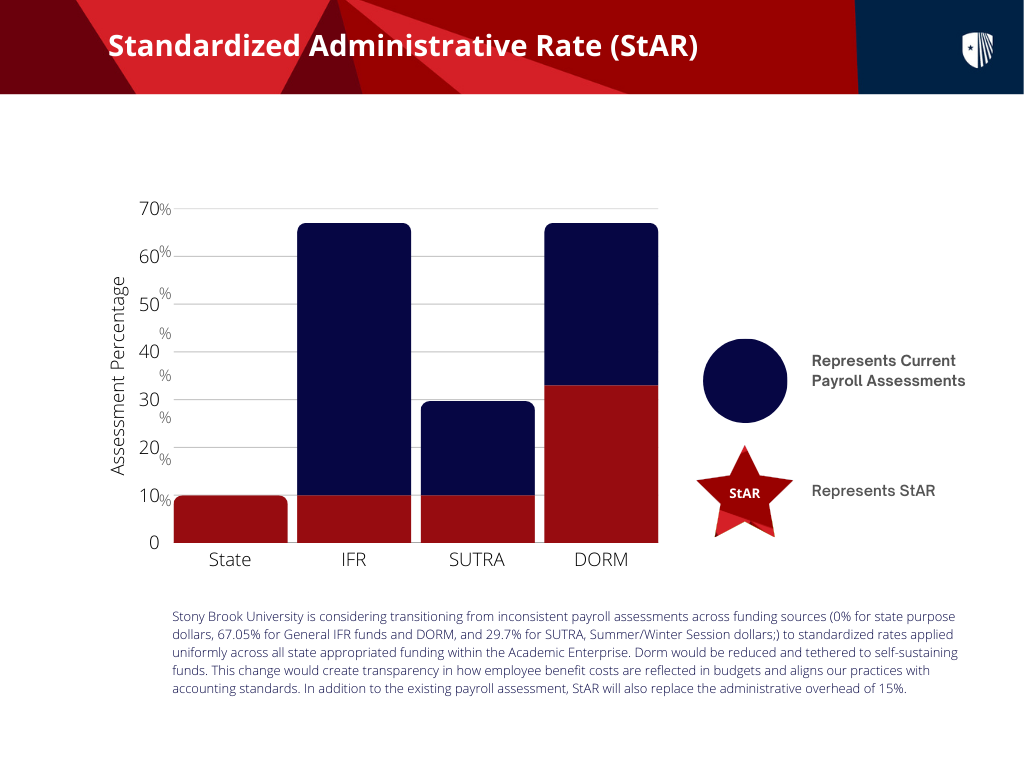SBU's Standardized Administrative Rate (StAR)
Stony Brook University's current payroll assessment has created inconsistencies in expense accounting, particularly for personnel expenses across funding sources, causing units to either pay assessments or undertake resource-intensive expense journaling processes that complicate institutional reporting and create administrative challenges. To address this issue, the institution is considering implementing a Standardized Administrative Rate (StAR) that would establish a single rate per fund category for all state-appropriated payroll costs — including Revenue Offset cost centers, General Income Fund Reimbursable (IFR) cost centers, and SUTRA cost centers — and equalize these through a University-wide subsidy. This initiative would also impact Dormitory payroll assessment by aligning it with other self-sustaining funds like Hospital and Veterans Home, representing a significant strategic shift to resolve current inconsistencies without infringing on the official NYS federal and state fringe benefit rates established by the NYS Division of Budget.
Standardizing Administrative Rates for Greater Flexibility
SBU is exploring the potential implementation of the StAR initiative. If pursued,
this strategic implementation would coincide with the New Economic Framework (NEF) rollout, as both initiatives represent fundamental transformations in the University's
financial structure and business operations.
What is the Standardized Administrative Rate (StAR)?
The Standardized Administrative Rate (StAR) is a reduced, uniform percentage applied
to employee salaries across state appropriated funding sources in the Academic Enterprise
at Stony Brook University (including Revenue Offset [State Purpose] cost centers,
IFR cost centers, and SUTRA cost centers).
Key Characteristics
- It would replace the current inconsistent payroll assessment rates (0% for state purpose dollars, 67.05% for General IFR funds, and 29.7% for SUTRA dollars)
- It would function as an assessment that will also replace the IFR/SUTRA administrative overhead rate
- If implemented, it will be applied automatically to salaries entered in the WolfieONE planning system
- It would be calculated by multiplying the applicable rate on all components of an employee’s regular salaries and wages
- It would be monitored annually by BFP&A in partnership with the Office of the Controller
- It does not supplant the New York State Division of Budget (NYS DOB) official fringe benefit rates. StAR is a Stony Brook University campus initiative to normalize assessments. It in no way reflects the actual costs to NYS of employee fringe benefits. Grants that endeavor to reimburse the State of New York for faculty’s research effort should continue to reference the official fringe benefit rates published on the NYS DOB website.
Benefits of Using a Standardized Administrative Rate
1. Simplified budget development
With the current method, developing a budget requires looking up every staff person's
benefit costs (health, retirement, etc.) to determine anticipated charges for the
year. With the new method, the Standardized Administrative Rate will automatically
be applied when a salary is entered in our future state planning system in WolfieONE.
2. More accurate financial planning
Our ability to plan for our financial future depends on accurate data. Using natural
classifications will better position us for future planning at Stony Brook. This would
also eliminate audit risk associated with journalizing equivalent transfers.
3. Alignment with the New Economic Framework (NEF)
Our New Economic Framework (NEF) will work most effectively with a Standardized Administrative Rate across State purpose
funds, IFR, and SUTRA accounts. As we build and test a new economic framework, this
would be the ideal time to implement such changes.
4. Following best practices
Using a Standardized Administrative Rate method aligns with practices at most research
universities, including our AAU peers.
5. Enhanced transparency
The Standardized Administrative Rate would allow for more transparent cost structures
in all budgeting processes and operating reports.
6. Consistency and strategic decision-making
This method would bring more accurate financial modeling and accounting to Stony Brook,
creating consistent budgeting across the University and enhancing strategic decision-making
capabilities.
7. Reduced administrative burden
This change would significantly reduce the administrative workload for those responsible
for developing and maintaining budgets and financial planning at SBU.
Suggested Timeline
Building the StAR
This is a tentative timeline subject to change as we explore this initiative depending
on actual project task completions. Please revisit this website periodically for updates
and the latest version.
StAR Development
Broadening Campus Awareness
Exploring Technical Components and Modeling
Potential Implementation
FAQs and Feedback
Have another question?
We're here to listen. Submit your message below, and our team will respond promptly.
Feedback Form


